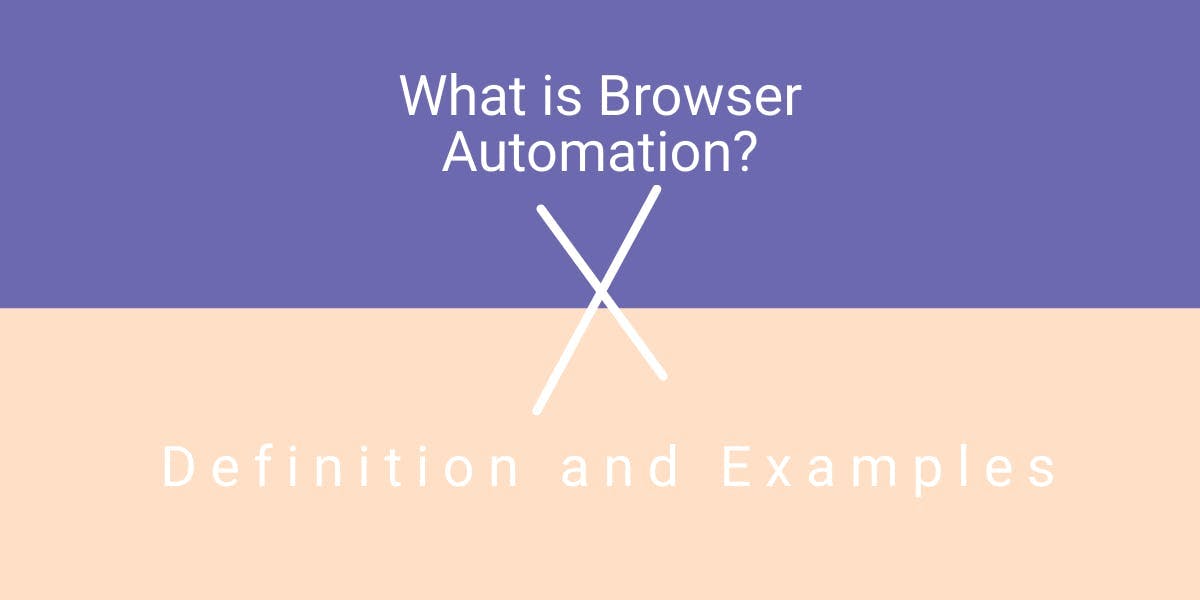What is Browser Automation? Definition and Examples
Flipnode on Apr 18 2023

Automating web browser tasks with browser automation tools is a great way to replace manual human labor. Bots can perform tasks with reduced effort, guaranteed efficiency, and speed that manual work can't match.
Browser automation tools utilize Robotic Process Automation (RPA) technology, where the automation software records user actions in the graphical user interface (GUI) of a website, browser, or web application and saves the list of actions. The automation program then executes these actions by injecting JavaScript into the targeted web page, repeating the actions directly in the GUI.
In summary, browser automation:
- Speeds up web browser tasks
- Scales the number of concurrent tasks
- Ensures accuracy by reducing human errors
- Lowers operational expenses compared to manual labor
With browser automation tools, you can automate a variety of web browser activities, such as filling out HTML forms, data extraction, browser navigation, and creating online reports. Although there are many more applications for automation programs, web testing is one of the most essential use cases for browser automation. Let's take a closer look at some of the fields where browser automation can be used.
Where is browser automation used?
Here are some of the most common use cases for browser automation tools:
Web testing:
Testing websites and web applications manually can be a time-consuming and arduous task. Automated web testing, on the other hand, can significantly speed up the process. There are three common types of automated web testing:
- Parallel tests: Testing websites and web applications on all available environments can be done simultaneously and on a large scale using automated parallel testing.
- Regression tests: Ensuring that recent updates to a website did not negatively affect performance and operation can be done quickly and easily by re-running test cases using automated regression testing.
- Performance tests: Testing the data processing and traffic load a website or web application can handle before failing can be done consistently over short and long periods of time using automated performance testing.
Routine tasks
Tasks that are repetitive and require little variation in navigation or input can be automated using browser automation. Examples include browser and web page interactions, website logins, and data input to HTML forms. Tools like AdsPower require no programming knowledge and are the most convenient solutions for this type of browser automation.
Web scraping
Although there are web scrapers designed explicitly for data extraction, browser automation is still an effective method to gather public data. Companies scrape information from search engines and various websites, such as e-commerce sites, to analyze results later and gain insights. Dedicated web scraping tools can usually extract data even from the most complex targets, but browser automation can still be used to automate uncomplicated information gathering within a process.
Broken hyperlink verification:
Another important usage of browser automation is to verify broken hyperlinks on websites. When a link doesn’t route to the desired site or returns the 404: Page not found error message, it's useless as it brings no value and wastes potential user traffic. Employing bots to verify hyperlinks on a large scale is favorable, particularly if you own a sizable website or web application. This way, you'll confirm the quality of content while also saving time.
Getting started with browser automation
If you're interested in getting started with browser automation, it's advisable to begin with a smaller scale project. Start by identifying a process in your day-to-day routine that involves repetitive actions on a web browser and requires predetermined input each time. Once you've found such a process, you can follow these steps to get started with browser automation:
- Process - Identify a process within your day-to-day activities that requires web browser usage.
- Questions - Determine whether the process involves repetitive actions on a web browser and requires predetermined input each time. If the answer to both is yes, then you can consider automating the process.
- Tools - Research browser automation tools with the features and capabilities to automate your process.
- Browser automation - Use the chosen tool to re-enact the manual process.
You can repeat this process until you find the best automation solution for your needs.
There are numerous browser automation tools available, but the selection depends on whether your team has coding knowledge or not. Selenium is a popular tool that offers three solutions, one of which is Selenium IDE. Selenium IDE is a straightforward browser extension that doesn't require programming expertise. It records your interactions with a website and then automatically re-enacts them.
While tools like Selenium provide more flexibility through programming languages, a no-code solution like Selenium IDE is suitable for businesses without in-house developers.
Browser automation: the challenges
During browser automation, one must anticipate challenges due to operational limits of bots and infrastructure. The three most common issues are as follows:
Scalability
The biggest challenge in browser automation is test scalability. It is necessary to test on a variety of browsers, operating systems, and versions of both. However, as time goes by, the process becomes more complex. Websites and web applications grow in size, requiring more test cases, resources, and time. Running and monitoring multiple tests simultaneously can be difficult, especially when the testing infrastructure is not designed for large-scale testing.
CAPTCHAs and pop-ups
CAPTCHAs and pop-ups pose significant challenges in browser automation. CAPTCHAs are a security measure implemented by websites to prevent bot activity, and require users to complete specific tasks, such as selecting matching pictures, to access a web page. These tests are dynamic and cannot be easily automated, as they present different challenges each time. Although it is possible to bypass CAPTCHAs with AI-driven bots, manual completion is often the most cost-effective solution.
Similarly, pop-ups such as "Do you want to leave this site?" can disrupt the flow of automated bots and prevent them from executing the next step in the process. These pop-ups are unpredictable and can be introduced with updates to websites and browsers, making it difficult to anticipate and circumvent them.
Dynamic content and geo-restrictions
The ever-changing content poses another significant challenge in browser automation. Whether you are automating routine tasks or extracting data using automation tools, website or web application modifications can result in unexpected outcomes. For instance, if you have automated a task, and the target site is updated, and a button's position or name is changed, your task will fail because the bot cannot find the button according to the predetermined steps. Thus, browser automation may require manual intervention to ensure task success.
Additionally, some content may only be available to specific geo-locations, making it impossible to automate restricted content if you are not in the required location. If you experience this problem, you can consider using proxy servers with your browser automation tool. However, some available solutions, including those that do not require coding knowledge, do not support proxy server integration. Before selecting a browser automation tool, you should evaluate whether proxy servers are crucial to your operations' success.
If you are looking for an easy-to-use tool that offers features like browser automation, browser fingerprint control, and proxy server integration for an undetectable browsing experience, AdsPower is worth considering.
Conclusion
Although browser automation can present various challenges, it is an extremely useful method for bots to simulate browser actions, extract information, conduct web testing, verify broken links, and perform many other tasks. While there are some limitations to what these bots can accomplish, they are still highly beneficial for increasing the efficiency and speed of various browser-related tasks.



